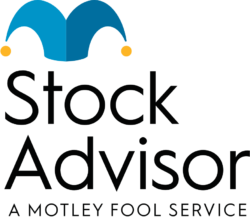Investing in individual stocks can be a rewarding way to earn passive income and expand your investment portfolio.
But not every stock is going to make money. Using one of the best stock newsletters can make it easier to consistently find winning stocks.
An investing newsletter isn’t going to recommend profitable stock picks each time. But newsletters can be a useful tool when researching stocks that fit your investment goals and risk tolerance.
Top Investment Newsletters
These newsletters cover a variety of investment strategies to help you build a diversified stock portfolio. Each newsletter recommends at least one new stock each month.
These newsletters are also affordably priced letting you use them if you invest small amounts of money. As a reminder, do your due diligence and research each stock to decide if it’s a good fit for your portfolio.
1. Motley Fool Stock Advisor
- For first-timer or a seasoned vets
- Offers the best bang for your buck
- Straightforward stock insights

Motley Fool Stock Advisor is one of the best overall newsletters for most investors. One reason is that you get two monthly stock picks.
Most monthly stock recommendations can be in one of these industries:
- Technology
- E-commerce
- Medical technology
- Finance
- Travel
- Cybersecurity
You may be familiar with several companies that Motley Fool recommends. But others may be brand-new to you but are leaders in their industry.
Stock Advisor recommends stocks they believe will outperform the S&P 500 index for the next three to five years. If you buy a Stock Advisor pick, plan on holding it for several years.
Their long-term “buy and hold strategy” is different from most stock newsletters which use trailing stops to reduce investment losses. Another newsletter may recommend selling if a stock price drops by 20%, for instance.
In addition to the two monthly stock picks, Stock Advisor provides a list of ten “Starter Stocks.” The Stock Advisor team recommends these stocks as a foundation for almost any investor.
Subscribers also have access to the entire recommendation history of Stock Advisor dating back to 2002. This access provides full transparency to see what some of the best and worst Stock Advisor picks were.
This history also builds trust with the investor as the stock newsletter history can be elusive. Many newsletters like to promote their best recommendations yet hide their average and worst returns.
Why We Like It:
- Two monthly stock picks
- Buy and hold investment philosophy
- Costs $99 for the first year
Best for: Two monthly stock picks, long-term investors
Price: $99 for new members for the first year and then $199
2. Seeking Alpha
- Offers crowdsourced research content
- Primarily written about individual investments
- Best for intermediate to advanced investors

Seeking Alpha Premium provides a wide array of opinions on stocks and ETFs from experienced investors.
Subscribers can also receive daily investment newsletters that focus on a specific sector or the latest market headlines. These newsletters are available with a free subscription too.
A premium membership includes these benefits:
- Receive up to 15 daily investment newsletters
- Unlimited article access
- Stock screener with exclusive stock ratings
- Listen to earnings and conference calls
There are 15 daily newsletters you can subscribe to for free. Each newsletters lists the highlights for a specific investing topic like the stock market headlines, dividend investing or global markets.
You can research investing ideas by contributor or by stock ticker. These articles can be an effective way to see the bull and bear reasons to buy, hold or sell a stock.
If you’re not sure where to start, there are many trending investing ideas on the Seeking Alpha homepage.
You can track new articles by stock symbol or follow a specific author.
Another benefit of Premium membership is tracking an author’s stock rating performance. An author must assign a bullish, neutral or bearish rating to each article.
This long-term transparency can be better than most newsletters. Other newsletters usually don’t publish their long-term performance once they exit a position. The Motley Fool Stock Advisor is a notable exception.
The stock screener tool is powerful too. You can research stocks using the Seeking Alpha Quant Ratings. This rating system can be more in-depth than many online brokers.
Some of the Quant Ratings screens include:
- Value
- Growth
- Profitability
- Momentum
- Earnings per share revisions
You can use these ratings to find growth stocks and dividend stocks.
Seeking Alpha provides more investing ideas than most newsletters. It’s possible to find ideas for almost any investing idea.
Why We Like It:
- In-depth research for stocks and ETFs
- 15 daily investment newsletters
- Quant Ratings stock screener
Best for: Reading bull and bear coverage of stocks and ETFs, screening stocks
Price: $19.99/month when billed annually or $29.99 month-to-month
3. INO Stock of the Week
- Free to use
- Straightforward stats and data
- Available on iOS and Android

The INO Stock of the Week is a free investing newsletter that sends a weekly stock pick to your email. You only need to provide your first name and email to enroll.
As this isn’t a premium service, you won’t get an extensive research report as some stock newsletters provide. You also won’t be able to track the performance of past recommendations or view a model portfolio of current holdings.
Each weekly report shows the following information:
- Company name and stock ticker
- Brief company background
- Fundamental reasons to buy the stock
- Technical reasons to buy the stock
INO doesn’t recommend when to buy or sell your shares as everyone’s investment situation is different. The stock pick doesn’t necessarily include the potential investment risks and reasons to sell.
You should use a stock screener or your broker’s research tools to provide in-depth research tools.
As you are getting a new stock pick each week, you may decide to avoid some suggestions that don’t match your investment strategy or risk tolerance.
It’s also difficult to invest in every stock idea if you can only invest small amounts of money.
In addition to the free weekly stock pick, INO offers a premium MarketClub platform for short-term trading. An annual subscription costs $449 but you get buy and sell signals for the stocks that interest you if you want to use technical data.
Why We Like It:
- It’s free
- Weekly stock pick
- Show fundamental and technical reasons to buy
Best for: Weekly stock pick, free investing newsletter
Price: Free
4. Value Line Investment Survey
- Free trial for all types of users
- Free to use
- Wide range of stock data

Value Line is a well-respected investment research firm founded in 1931. There are several investing newsletters to choose from in print and online.
The Value Line Investment Survey is their flagship product with several different versions. Each version covers a different number of stocks.
- Selection and Opinion: Weekly research reports for four model portfolios that each consist of 20 stocks ($199/year).
- Investor 600: Covers 600 large, actively traded companies. Can be best for conservative investors as these stocks are more stable ($199/year)
- Investor 900: Includes Investor 600 stocks plus 300 small and mid-cap stocks. Better for more aggressive investors ($249/year)
- Small Cap Investor: Covers 1,700 small and mid-cap stocks ($225/year)
- Savvy Investor: Reviews 3,400 small and mid-cap stocks ($795/year)
The weekly market commentary can be similar to reading financial magazines.
As there are hundreds or thousands of stocks to compare, Value Line includes a ranking system to find potential ideas. You will need to decide which stocks to invest in as Value Line doesn’t recommend specific stocks in each report.
Why We Like It:
- Weekly market reports
- Extensive coverage
- Reviews large, mid and small-cap stocks
Best for: Weekly stock market reports, covers most American stocks
Price: $199 to $795 per year
5. Stansberry’s Investment Advisory
- 30 day trial period
- Competitive newsletter pricing
- Long standing company since 1999

Stansberry’s Investment Advisory is the flagship stock newsletter of Stansberry Research. It costs $199 per year.
You get one new monthly stock pick and a daily market commentary via email. The daily commentary includes free insights from some of the other Stansberry newsletters.
The newsletter states the average holding period is at least one year per stock pick.
The stock picks come from a variety of industries including:
- Technology
- Biotech
- Banking and finance
- Insurance
- “World Dominators” (Industry-leading companies)
These stocks have high trading volumes and some are already household names. You can buy these monthly picks using any free investing app.
Each monthly recommendation includes a multi-page story describing the reasons to buy the stock and why you might sell. This newsletter also has a maximum buy-up-to price and uses trailing stops to help you decide when you might sell the stock.
The monthly newsletter also performs a portfolio review of the existing holdings. They are rated as a buy, hold or sell.
You can use this guidance to help research stocks and choose which ones to buy or avoid.
Other Entry-Level Stansberry Research Newsletters
You might get an offer to add a discount subscription to another Stansberry entry-level newsletter. These newsletters have a broad focus but recommend different stocks than Stansberry’s Investment Advisory.
There are two other entry-level newsletters:
- Retirement Millionaire: Recommends large-cap stocks and ETFs for retirement
- True Wealth: Invests in stocks that are “cheap, hated and in an uptrend”
Both products have a similar $199/year price tag. True Wealth is the most aggressive of the three options with Retirement Millionaire as the most conservative.
However, Retirement Millionaire isn’t a substitute for earning fixed income as it’s not going to recommend “ultra-safe” bonds and CDs.
Expect to buy stocks of growth-focused companies like Amazon that don’t pay dividends but are not volatile like a penny stock or a fast-growing small cap tech stock. Other recommendations can pay a dividend.
Stansberry’s Investment Advisory does a good job of balancing the more aggressive strategy of True Wealth with the relatively more conservative large cap stocks that Retirement Millionaire favors.
Why We Like It:
- Recommends stocks from many growing industries
- Can read a daily market recap summary
- Extensive research report for each monthly pick
Best for: Buying stocks from multiple industries, one monthly stock pick
Price: $199 per year
6. Nate’s Notes
- Long standing since 1995
- Short and easy to read style
- Offers advice to grow long-term wealth
Nate’s Notes is one of the oldest stock newsletters starting in 1995. This monthly publication consistently has some of the most consistent performance track records according to Hulbert’s Financial Digest which tracks newsletter performance.
It’s run by Nate Pile who was one of the first investors to recommend buying Apple stock in the late 1990s. His specialty is investing in biotech and high-tech stocks.
The newsletter has a model portfolio of “core stocks” and “non-core stocks.” Nate recommends buying more core stocks as their share prices can be less volatile.
Each month, the newsletter reviews the performance of the largest stock market indexes like the S&P 500 and Dow Jones Industrial Average.
Nate also reviews the stocks in the model portfolio. As there are many picks to choose from he may recommend selling a full or partial position depending on the stock performance.
He also recommends new stocks and ETFs but the newsletter doesn’t mention a minimum number of new monthly recommendations.
There is a model portfolio and an aggressive portfolio. The newsletter labels stocks with the best price-to-growth potential as “First Buys” that investors can buy first.
Each portfolio has a “Buy” and “Strong Buy” price point. Investors can use the price recommendation to decide how much stock to buy.
Why We Like It:
- Two model portfolios
- Favors high-tech and biotech stocks
- Recommends the best stocks to buy first (i.e., “First Buys)
Best for: Investing in biotech and high-tech stocks, two model portfolios
Price: $289 per year
7. Empire Stock Investor
- Expertise and accurate stock news from editor Whitney Tilson
- 24/7 online access to special reports
- 30 day money back guarantee

Legendary investor and former hedge fund manager Whitney Tilson oversees the Empire Stock Investor newsletter.
Some consider Tilson to be one of the industry’s most well-connected professional investors.
Empire Stock Investor is an entry-level newsletter that mostly recommends large cap stocks. Subscribers get one new stock recommendation each month with an average holding period between three and five years.
Subscribers can also read Whitney’s daily e-newsletter which provides his insight on the latest market news and investing trends.
Why We Like It:
- Run by a highly-respected former hedge fund manager
- Recommends large cap stocks which can be less volatile
- Access to a daily e-newsletter that cover current market events
Best for: Investing in large cap stocks
Price: $49 for the first year and then $199
8. Zacks Premium
- Rates most stocks and funds
- Free and paid content
- Straightforward stock insights

With Zacks Premium, you can enjoy an extensive collection of free and exclusive analysis from America’s leading investment research firm.
Each month, this specialized insight can be an excellent tool for finding multiple investment ideas instead of waiting for a single monthly stock pick.
The platform offers daily market commentary and free stock ratings.
A paid subscription gives you access to these features:
- In-depth research reports for stocks and funds
- Focus List model portfolio for long-term investment ideas
- Stock screener
- Exclusive ratings
- And much more!
Zacks’ newsletter can simplify the process of buying individual stocks for short-term trades.
Their proprietary system, The Zacks Rank, has beaten the market by an average of +25.08% for more than 30 years.
Using earnings estimates, it approximates the probability a company will outperform the stock market.
The free version can suffice for basic research. However, upgrading to Zacks Premium ($249/year) is better if you want access to in-depth research reports, model portfolios, stock screeners, and many other invaluable resources.
These tools can be useful and time-saving if your online brokerage doesn’t provide third-party analyst reports.
Like many stock newsletters, you have a 30-day trial period for Zacks Premium.
Why We Like It:
- Analyzes many stocks and funds
- Short-term and long-term investment ideas
- Daily market commentary
Best for: Investing in multiple strategies, in-depth research reports
Price: $249
9. Fidelity Investor
- Jim Lowell’s strategies have boosted members’ annual income two-fold
- 100% money-back guarantee
- 30 day trial

There are a few newsletters that recommend investing in mutual funds. Fidelity Investor is a good option if you want to buy Fidelity mutual funds.
This online broker has one of the largest families of actively managed mutual funds. Not every mutual fund is worth holding due to high fees and underperformance compared to index funds.
Instead of looking at the mutual fund name, this newsletter focuses on the current fund manager. The best managers can be more likely to outperform the market more consistently.
Of course, any active mutual fund will have periods of underperformance. It’s important to research the investment strategy, mutual fund fees and diversify your portfolio.
Fidelity Investor has five different mutual fund model portfolios:
- Global Quant Growth
- Global Quant Income
- Growth
- Growth & Income
- Income
These model portfolios recommend several Fidelity-managed mutual funds. Many Fidelity mutual funds have low investment minimums and competitive expense ratios.
One benefit of buying mutual funds is getting exposure to multiple stocks with one investment instead of only one company.
There are many Fidelity mutual funds. But investors will need to have a Fidelity brokerage account to use this newsletter to avoid sales commissions and high investment minimums that other brokerages may charge.
Why We Like It:
- Focuses on mutual funds instead of individual stocks
- Most funds have low investment minimums
- Fidelity is one of the largest mutual fund families
Best for: Investing in Fidelity mutual funds, growth or income investing
Price: $34.95 for the first 6 months, then $229 per year
10. Buyback Letter
- Money back for 30 day trial
- Wide range of stock data
- Well known go to for investment research

The Buyback Letter covers companies currently engaging in stock buybacks.
Many companies repurchase shares which reduces the total number of outstanding stock shares and can increase the stock price. However, stock buybacks don’t guarantee rising share prices.
Several factors, including company growth and positive investor sentiment, can help share prices to rise too.
The standard edition of this newsletter is the most budget-friendly option. It costs a reasonable $195 per year.
A Standard membership includes these perks:
- Six model portfolios
- Buy, sell and hold recommendations
- Weekly market insights
Upgrading to the premium edition costs $79 per month making this option an expensive newsletter. This version comes with a five-stock portfolio that changes monthly meaning you may have to sell your shares every few weeks.
Why We Like It:
- Recommends multiple stocks
- Tracks stock buybacks
- Multiple investment strategies
Best for: Investing in companies buying back shares, several model portfolios
Price: $195/year (Standard Edition) or $79/month (Premium Edition)
Oxford Club Communique
The Oxford Club Communique is the flagship newsletter of the Oxford Club investment research firm. You will receive one monthly stock pick for large-cap stocks with promising growth potential.
This newsletter also features investment ideas that are more volatile but can have more upside potential, if successful. These recommendations are separate from the standard model portfolio and are usually for biotech companies developing cutting-edge medical technology.
The annual subscription fee is also competitive at up to $79 per year for a basic subscription. The quality of research of investment recommendations are similar to other flagship investment newsletters from popular publishers.
Why We Like It:
- Three model portfolios
- 365-day 100% money-back guarantee
- Affrodable pricing
Best for: Investing in large-cap stocks and biotech companies
Price: $49 for the first year and then $79 ($129 for a print subscription)
Motley Fool Rule Breakers
Aggressive investors may appreciate Motley Fool Rule Breakers which invests in growing companies that are still too volatile for entry-level newsletters.
You will receive two new stock picks each month that are primarily for technology and biotech companies.
On the weeks without a new recommendation, you receive an update the best best five stocks to buy now within the model portfolio.
Consider joining Rule Breakers if you’re looking for something more aggressive than Motley Fool Stock Advisor if you have a higher risk tolerance.
Why We Like It:
- Two monthly stock picks
- Aggressive investment strategy
- Affordable first-year price
Price: $99 for the first year and then $299 each renewal
Read our full review to learn more.
FAQs
An investment newsletter can be worth the subscription if the potential investment gains exceed the annual subscription cost.
Using a stock newsletter can also help you find legit investing ideas instead of relying on market headlines to invest. Only trading the headlines and not performing in-depth research can make it more likely to lose money than gain money.
As always, research every recommendation on your own to understand the potential risks and rewards. Also, decide if the recommendation compliments your investment strategy.
As your investing skills and confidence increase, you may be comfortable researching stock ideas without a newsletter.
You may decide stock newsletters are not worth it if you don’t buy enough of the recommendations to justify the subscription cost.
Many entry-level stock newsletters cost around $200 per year. Many of these newsletters recommend large-cap stocks that can be well-known and are usually a dominant company in their industry.
More expensive newsletters can cost between $1,000 and $3,000 per year. These newsletters tend to focus on small-cap and mid-cap stocks that are more risky than large-cap stocks but can produce more profit if an idea succeeds.
Pricier newsletters may focus on a specific investment idea, such as:
-Investing in individual bonds
-Value investing
–Buying gold coins and precious metals
-Private placements for accredited investors only
Most newsletters recommend one new pick each month.
Motley Fool Stock Advisor is one stock newsletter that recommends two new stocks every month. It has a $199 annual cost ($99 for the first year) which is the average price of newsletters that produce one monthly pick.
Summary
Investment newsletters can be a useful tool but not every investment idea will be profitable. It’s important to research each recommendation and only invest in stocks that fit your investment goals and risk tolerance.
Related: Morning Brew Review: Is it Worth it?



